A 1,000-Year-Old Umbrian Castle
Issue 003: A castle, a Count, and a cozy chill in the air at Reschio, hidden in Tuscany's less famous, equally enchanting, and much spookier neighboring region.
Introduction
I know, I know, we’re back to Italy so soon… This honestly wasn’t my intention—the goal with this project is to take you to as diverse a set of locations as possible—but opportunity brought me to an incredible hotel I’ve been dying to stay at, and I didn’t want to wait to share. Plus, it’s in a hauntingly beautiful medieval castle. For our first (and perhaps only ever) Halloween issue?! I couldn’t resist.
The property in question is Reschio, a breathtaking 10th-century fortified stronghold that was converted into a luxury boutique resort by a bonafide Count, Benedikt Bolza, who happens to be a London-trained architect as well as Austro-Hungarian nobility. His father, Antonio, purchased the estate in 1994, and the family lived in the crumbling castle for a decade before the extensive restoration work began. Exploring and learning about everything that the Bolzas have achieved across the property over the past 30 years, and experiencing first-hand their unique approach to hospitality—which involves a lot of clever design tricks—was a real treat.
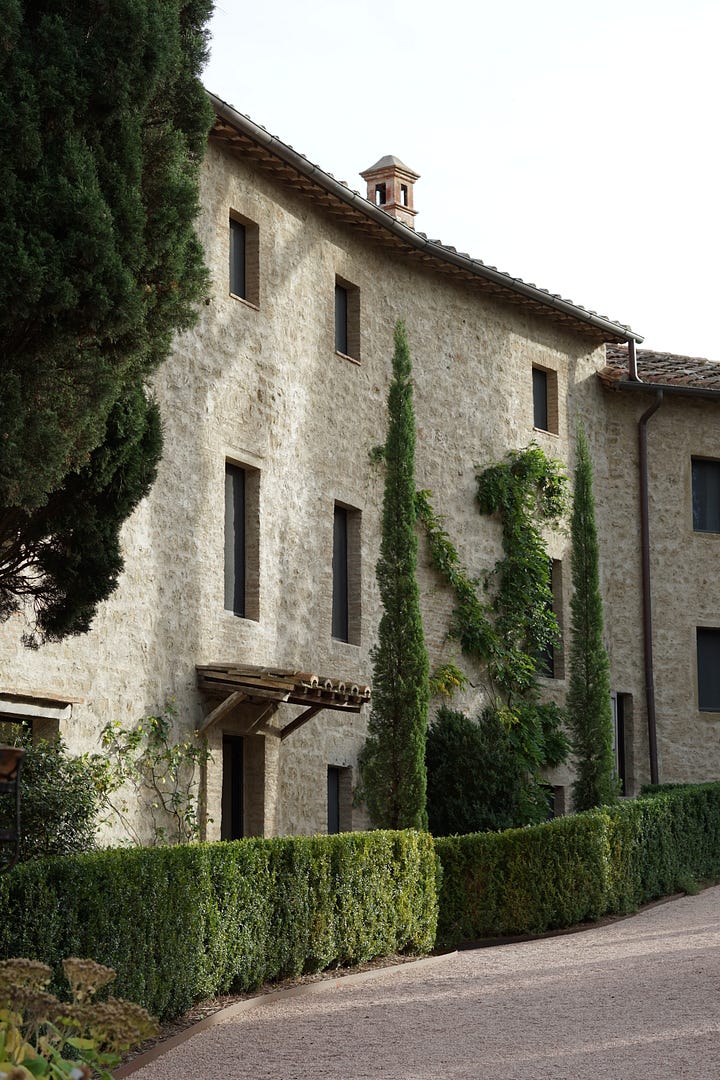
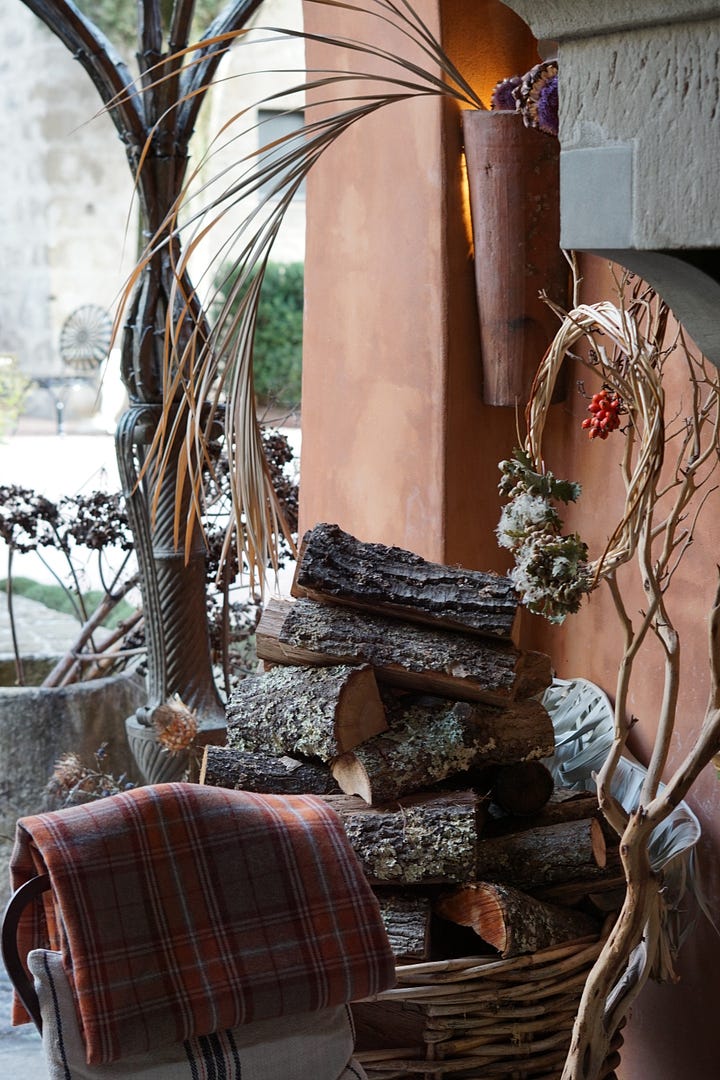

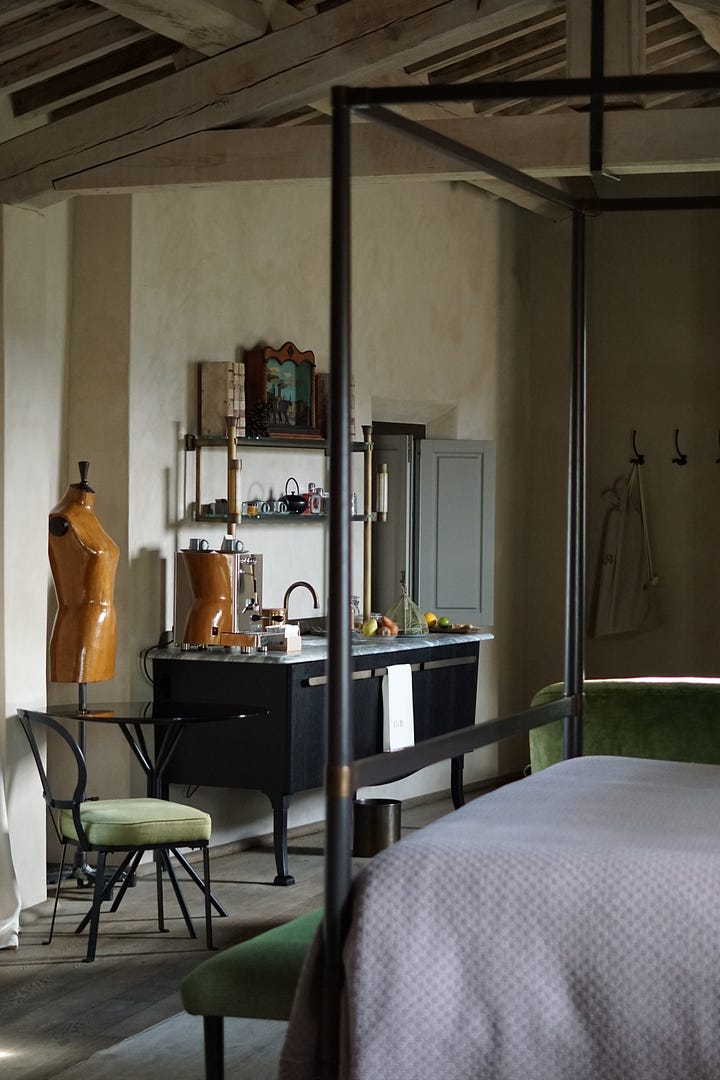
This trip was also an amazing chance for me to revisit Umbria, a mountainous region of central Italy that really doesn’t get enough air time. Tuscany, its neighbor to the northwest, has many more recognizable cities, better-known historical ties and figures, and heaps of spectacular monuments. And frankly, better PR (credit to Diane Lane in Under the Tuscan Sun, for one). But Umbria offers equally captivating rural beauty—though more rugged and wild—and a handful of historic towns to explore with a fraction of the tourists, which makes it all the more appealing to me. Don’t all go rushing there at once!
I first came to Umbria over a decade ago on a press trip with Jaguar, which was one of the most lavish experiences of my life to date. Myself and my friend Zuli were flown first class, helicoptered(!) from Rome to Assisi, then spent three days driving around the countryside in a brand new F-Type and eating mostly truffles. Oh, and we ended the trip at the British Ambassador’s residence in Rome, which was has an ancient aqueduct running through its gardens. No biggie. So the bar was set high, but I managed to pole-vault over it (without my junk getting in the way) during this October 2024 visit.
Umbria
There are multiple reasons why Umbria is perfect for spooky season (we’ll get to the castle later). The name Umbria comes from the Latin word “umbra,” meaning “shadow,” presumably because the area was once covered in dense forest. One of only four Italian regions not “kissed by the sea” as locals say, Umbria makes up for a lack of coastline with enough fortified hilltop villages, towns, and cities to fill any ambitious itinerary (I’ve outlined the ones I was able to visit as part of my week-long itinerary below). These beige-stone medieval mazes—which were all at war with one another during the Middle Ages—are perfect for wandering and getting lost, pretending you’re a character in a fantasy novel, and stopping for pizza or gelato wherever it appears (which is frequently).
Umbria is also the “green heart of Italy,” according to a tourism poster that greeted me at Rome’s Fiumicino airport baggage claim. But the leaves were just starting to change as I arrived in mid-October, turning the landscape into an ochre-speckled spectacle. A traffic-laden drive north from Rome in my oh-so Italian Fiat 500 took me through some gorgeous scenery, even along the highway, then along precariously winding mountain roads that have to be traversed to reach most destinations. As an infrequent driver, and trained on the British side of the road, it took me a while to assimilate to my little manual-drive car. But it was the best way to get around and experience as much of Umbria as possible in the time given.
Perugia
Umbria’s studious capital, Perugia, sits high and proud on a large promontory in the region’s center as its municipal and cultural heart. The city isn’t one I’d heard much about—compared to Florence, Siena, and Pisa over in Tuscany—but it certainly has its fair share of significant history and sites. One of the ancient Etruscan cities settled before the Roman Empire, this is where St Francis (from nearby Assisi) was imprisoned after a revolt against Perugia’s nobles, which apparently led to his conversion from solider to a life of prayer. Today, Perugia is a university city, attracting many local and foreign students, and is also known for its chocolate “baci” (kisses) that are popular across Italy and ship worldwide.
A bit of a maze, and not the easiest to drive through (I parked outside the city walls for free and hiked up), Perugia’s well-preserved center is at least compact and very walkable, with several wide pedestrian thoroughfares featuring a fair supply of (not amazing) outdoor dining spots and market stalls connecting its monuments. Of these sites, the tourists’ fave is the Fontana Maggiore, which is certainly impressive, surrounded by tiers of intricately carved stone figures like an oversized wedding cake. The backdrop of Piazza IV Novembre, with the Cattedrale San Lorenzo on one side and Palazzo dei Priori on the other, makes for an impressive and transportive setting in the city’s historic core.
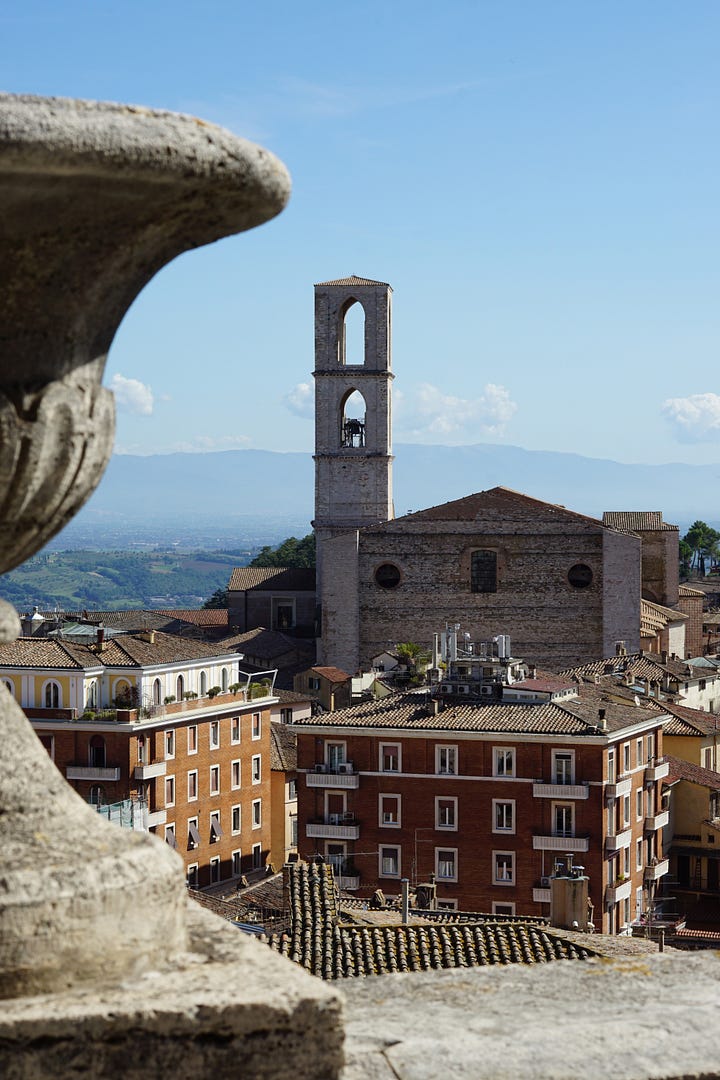

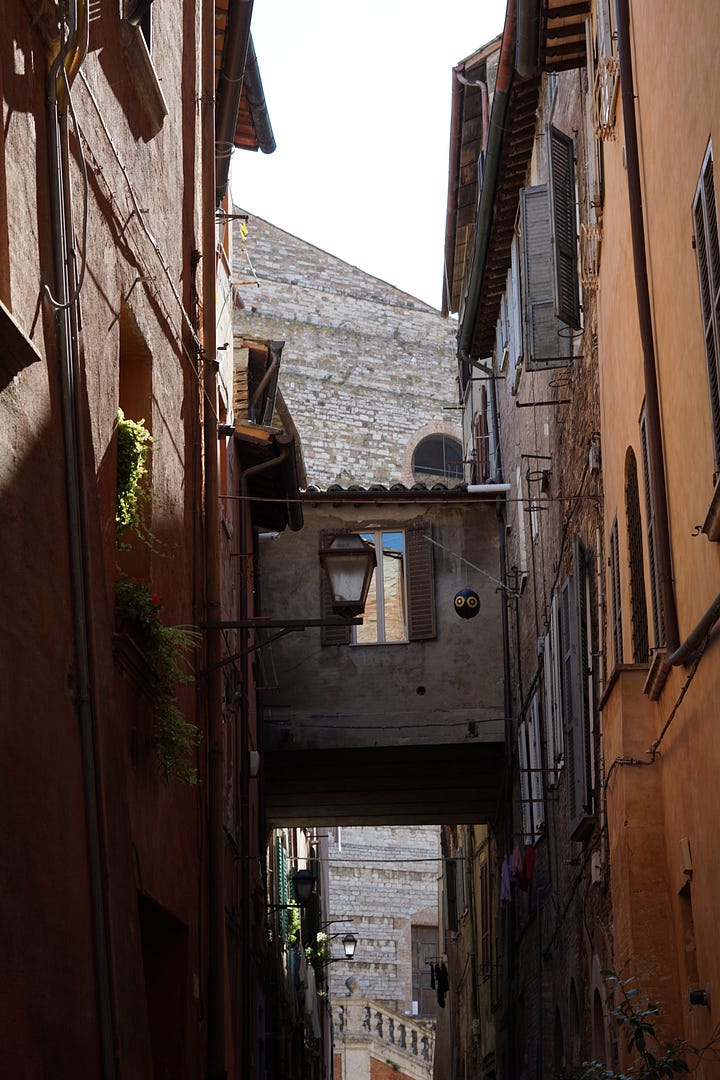
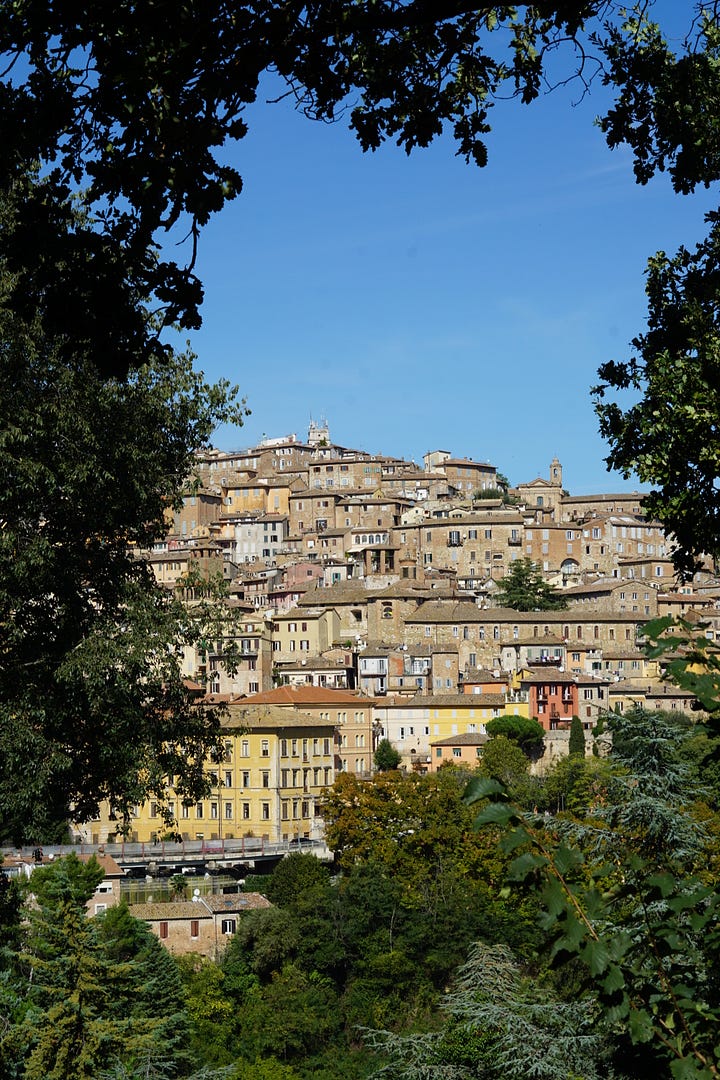
The best view in Perugia for me was from the Giardini Carducci, facing out and over the city’s tiled roofs and church towers, and across the Umbrian countryside. From this height, the panorama really shows off the region’s beauty and drama. Had it been rainy, I would’ve been more compelled to explore Perugia’s museums, palazzos and churches—of which there are plenty. But, the weather was fortunately too beautiful not to enjoy, so I stayed outside and wandered for most of the time. No complaints.
Gubbio
Gubbio is such a sweet little place. In the northeast of Umbria, the city steps up a steep hillside and dates back to Roman times—there’s a ruined amphitheater at the base of the slope to prove it. The town itself is a doglegged lace of narrow streets that gradually (and sometimes steeply) snake up to the Palazzo Ducale and Cathedral at the top of the town, about halfway up the hill. To reach these sites, a wander through the streets—particularly those away from the main drag-is very worthwhile. The homogenous color of the stone against the forested backdrop, plus some autumnal foliage to boot, was so scenic and it felt very soothing (for the mind, not the calves).
The city’s most impressive site is Palazzo dei Consoli, which has a sturdy cuboid shape reminiscent of Lord Farquaad’s castle from Shrek, albeit scaled down. The pale-stone building overlooks the valley below and the mountains far on the other side, while a substantial and strangely empty adjacent piazza allows visitors to take in the vast grandeur of the palazzo and the view simultaneously. My brief time in Gubbio involved no food, drinks, or tours (neither the amphitheater nor palazzos were open on Monday), but the walk was invigorating and the overall vibe of the city was worth even a short visit.
Orvieto
I had planned to visit Orvieto, 1.5 hours north of Rome, the day I landed in Italy. But a delayed flight and a long wait at the car rental desk had other plans, so I saved it for the journey back. And it was a great way to end the trip. Perched high on a large tuff cliff, the small city packs a lot into a relatively small footprint. I parked down the hill at Campo della Fiera, outside the imposing citadel walls, and took an elevator that conveniently brought me out on top of the fortifications where the view over the countryside was stunning.
The Duomo, which was built in 1290, is wrapped in black and white stripes similarly to Siena’s, and its front facade is just as ornately decorated. The impressive cathedral presides over the otherwise low-rise, tightly packed buildings that comprise Orvieto’s Centro Storico, clustered around a main commercial axis known as Corso Cavour. A string of touristy shops and little cafes line the street, but I didn’t have time to stop in any. There were more tourists here than other spots I visited in Umbria, likely because the city is just off the main highway from Rome to Florence, though it was hardly overrun.
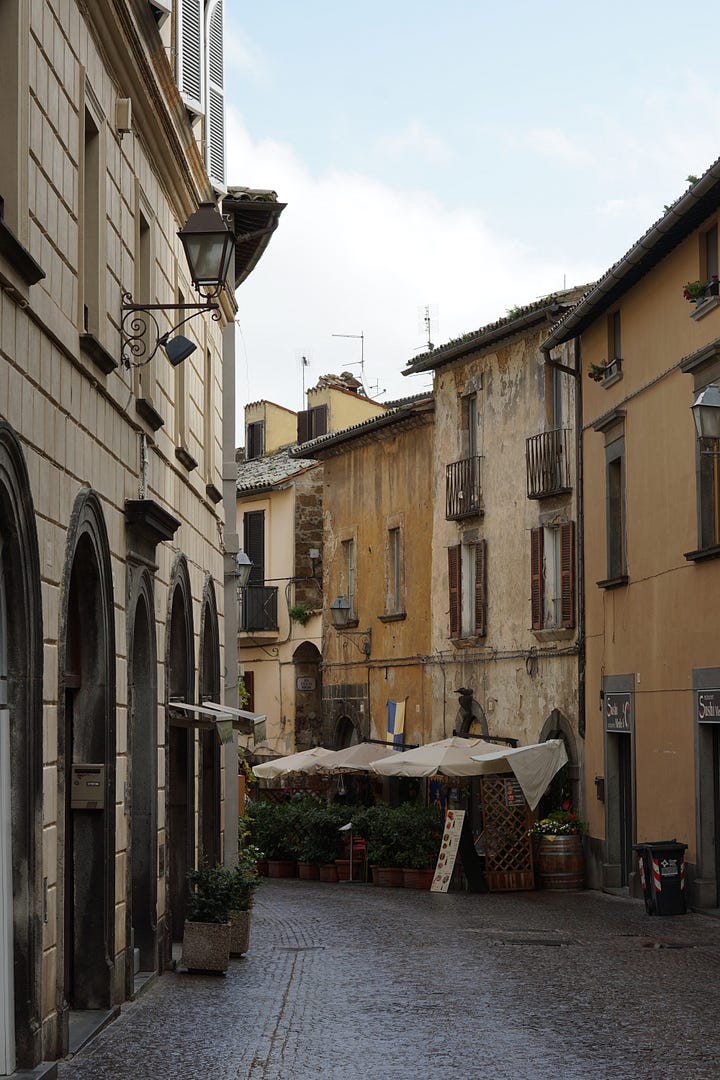
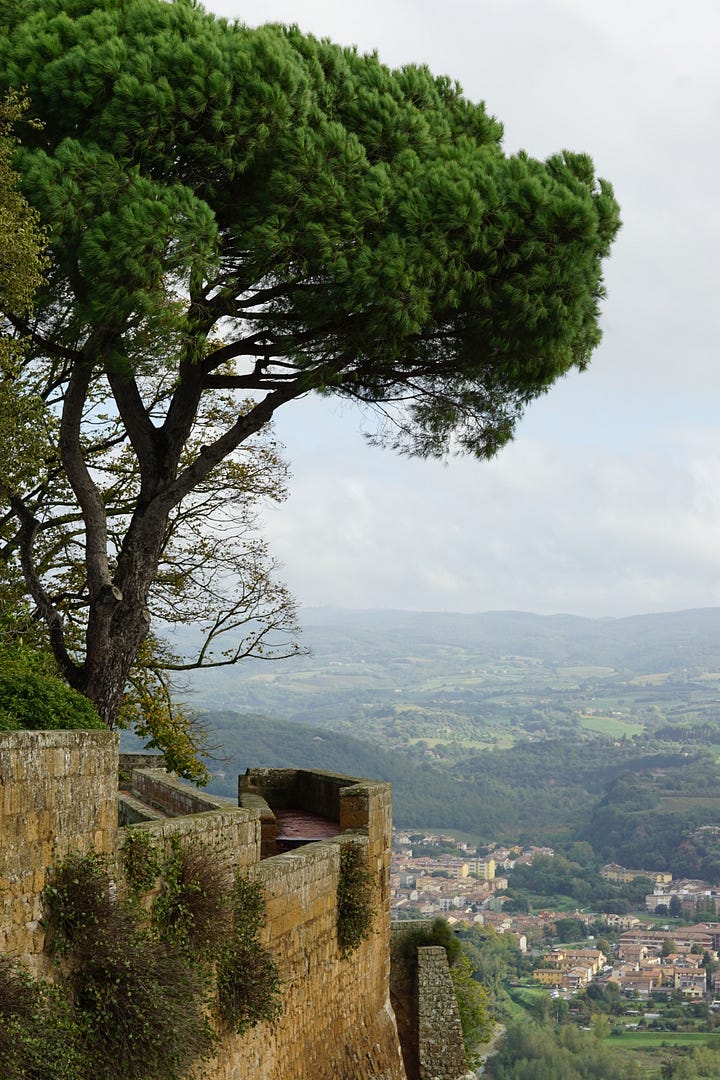
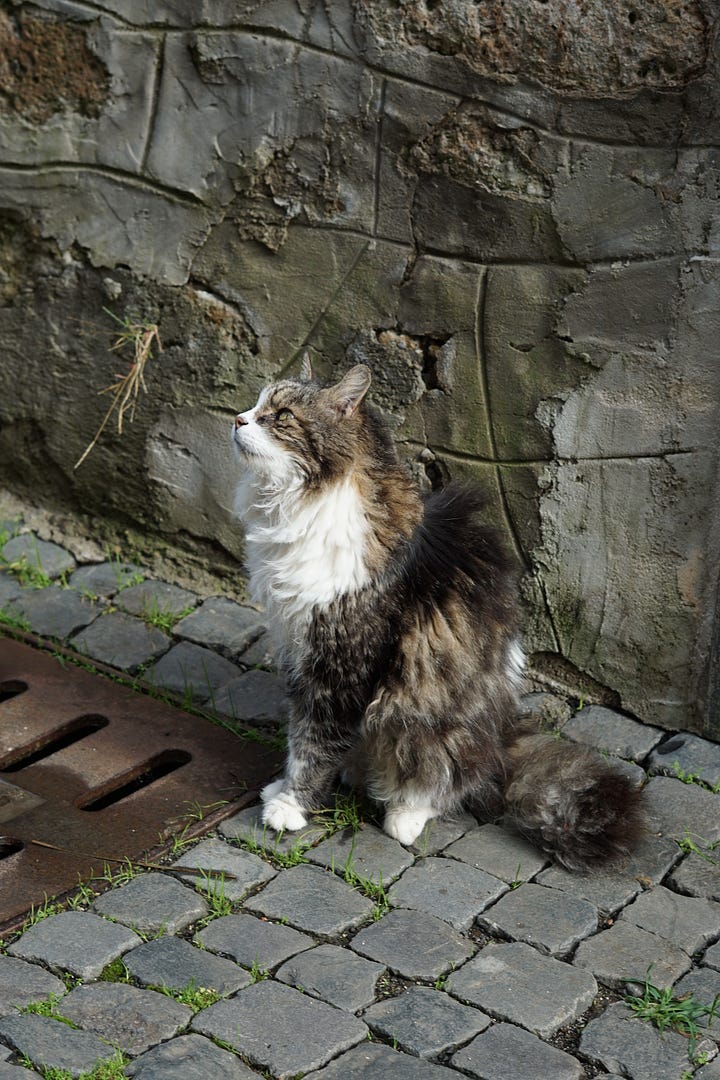
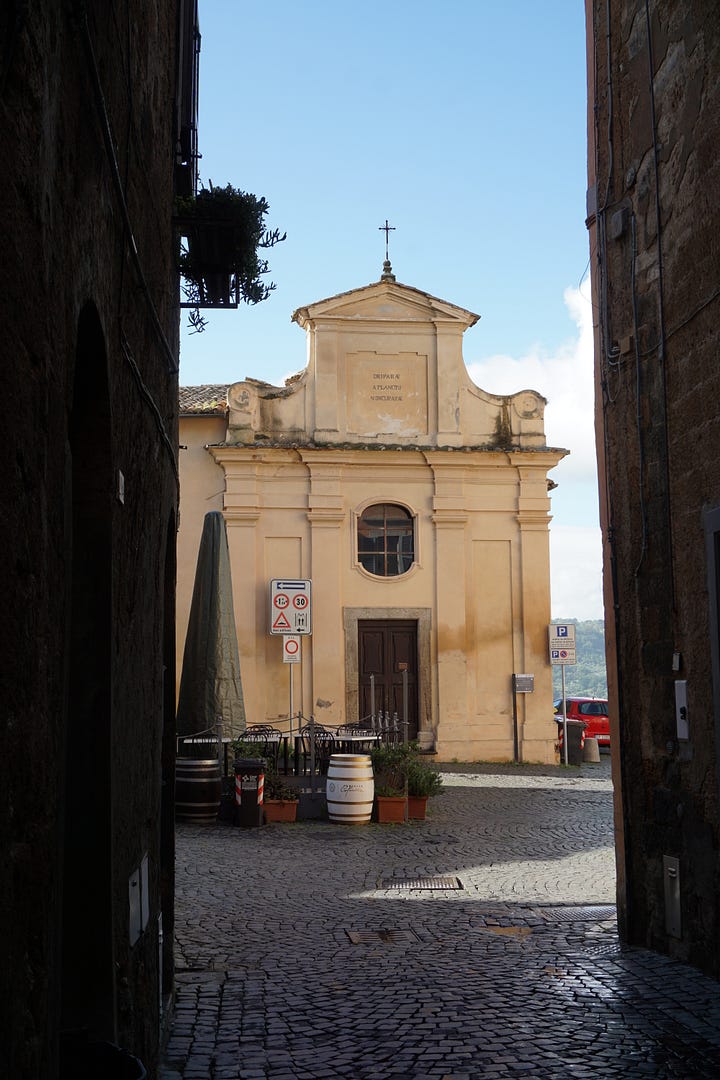
I walked all the way down Corso Cavour to Rocca Albornoziana, the extra-fortified area at the city’s eastern end. Through the medieval Porta Rocca gate, a park area now occupies the historic fortress, and it’s possible to circumnavigate its walls that are dizzyingly high above the aforementioned highway and parallel train line far below. This infrastructure somewhat ruins the view that stretches for miles beyond, but the turning foliage somewhat made up for it.
Sidebar: Just before my trip, Rick Costanzo, the Americas president for Bang & Olufsen, highly recommended I visit a restaurant called La Pergola Orvieto, but sadly I didn’t have time for that either (flight to catch). I trust his taste, so I figured I’d share here.
Reschio
Reschio is a bonafide Instagram star, boasting almost a million followers and popping up in my feed (and I’m sure many other people’s) on at least a weekly basis. But this isn’t an Instagram destination per se, as most of the online content is created by the in-house marketing team. Guests are actively discouraged from taking pictures (I got several looks while exploring with my camera) and are not allowed to photograph others staying there to protect their privacy. Both the remote location and the cost also prevent crowds of influencers from descending upon the hotel: the cheapest rooms start at €925 (around $1,000) per night.
I first learned about Reschio through my friend Andrea Franchini, who suggested I write about its 2021 opening. I couldn’t visit during that post-Covid era, but I did cover the hotel for Dezeen, and was immediately captivated by the property and its story. Set on 3,700 acres(!) of land, the sprawling estate has 50 historic farmhouse properties scattered across its rolling hills that extend as far as the eye can see. To date, 31 of these have been restored or rebuilt as ultra-luxury residences—eight of which are available as villa rentals. But we’ll focus on the hotel, located within the historic castle and across the surrounding buildings and land, where I spent four nights with a small group of fellow journalists.
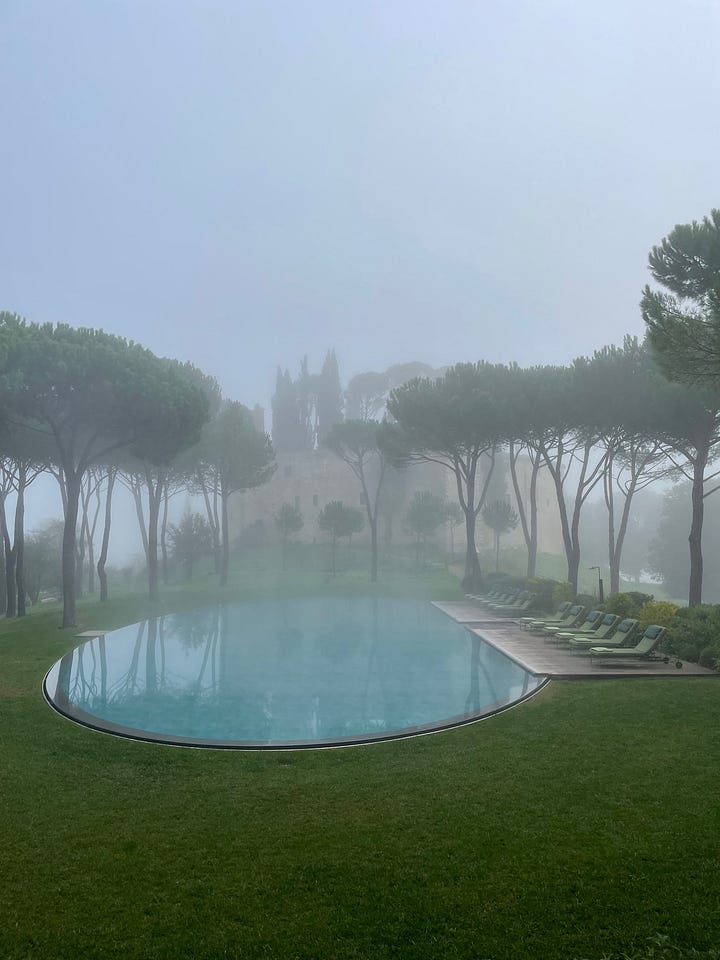

The Castello has 36 suites within its thick stone walls, plus a restaurant, spa, and communal bar and lounge areas. Sat atop a hill, as most castles are, it holds a commanding spot overlooking the dramatic countryside of Umbria (and Tuscany, since it’s right on the border). Across its grounds, broad umbrella pines and sentinel-like cypresses add to the stereotypical Italian landscape, which gains the golden hues of changing foliage in the autumn. Given Reschio’s russet color palette, wealth of cozy corners and fireplaces, and variety of indoor and outdoor activities on offer, this season really felt like the most appropriate time to visit.
Spending time within the castle walls is a bit like entering into a Disney-fied Game of Thrones, where staff dressed in slightly comical uniforms (costumes?) cheerfully bid guests “buongiorno” as they rake the gravel pathways, trim the already immaculate lawn and hedges, and light torches in the evening. Everything is almost too perfect, adding an eerie quality to the property—particularly in the mornings when the hotel is often shrouded in dense fog. The estate is also so vast that you rarely encounter more than a handful of other guests, even during full occupancy, and the staff-to-guest ratio can sometimes feels a little intense.
Given that it was almost Halloween, I had to ask if the castle is haunted. Count Benedikt—who, if you remember from earlier, lived in the castle for years—assured me that it’s not, which was slightly disappointing. But after a later conversation about supernatural encounters over digestifs, two of my trip-mates separately experienced flickering lights in their rooms later that night… It’s also a little scary walking from one end of the property to the other at night, because the darkness and quietness is so enveloping in such a remote spot. I was a little spooked getting up for the bathroom in the middle of the night, too. But this all adds to the experience: a 1,000-year-old castle needs to be little spine-tingling, at least!
Architecture & Design
Reschio is blessed with exceptional bones; it’s difficult for such a formidable structure to be anything but spectacular. The Castello itself forms a ring around a central courtyard, creating a natural hub and providing access to the majority of the suites. The building was restored to be as faithful to original as possible, reusing many materials like the stone and the timber ceiling beams, while bringing it up to contemporary five-star standards. A lot of structural work that it took to modernize the castle is cleverly hidden, so as not to detract from the overall effect.
The best (and most photographed) view of the castle is from behind the oval-shaped swimming pool, which is cleverly designed without an edge treatment so that appears as a reflective, deep-turquoise disk placed on the grass—its surface mirroring the imposing walls and the surrounding umbrella pines. Due to the pool’s unique shape, Count Benedikt had to engineer a cover that emerges from the central axis and unfurls like a spreading ripple to reach the perimeter. Another clever trick.
Contrasting the centuries-old stone building, the newly added Palm Court is akin to a Victorian glass house filled with tropical plants and equally tropical-themed furniture—custom designed by Count Benedikt as part of his B.B. for Reschio line. Inserted into a gap between the historic stonework, the space acts as a sort of reception area (although check-in happens in the guest rooms) and lobby bar, and provides a whimsical shift in style from the other communal areas.
B.B. for Reschio furniture is installed throughout the hotel, from the restaurants to the guest rooms, and has a unique look that blends classical and contemporary. It’s designed at the Tabaccaia, a former tobacco factory on the estate that was converted into offices and studios, and all made by local artisans and craftspeople. The branding used across the property—applied to dinner menus, marketing materials, and labels for homemade gin and amaro—was also designed in-house, and has an art deco leaning that’s slightly incongruous with the setting, but still beautifully executed.
Guest Rooms
The suites at Reschio are as atmospheric you might expect, and each is unique in size, layout, and decor—designed as subtle homages to various Bolza family ancestors through details, artworks, and photographs. I stayed in no. 3, with horse-y hints, which is located at the far end of the main castle building opposite the entrance, and closest to the pool access. From the upper-floor vantage, the framed dual-aspect views of the rolling landscape and the central courtyard are picture perfect, and the exposed ceiling beams, four-poster bed, velvet seats, dark wood vanity, and brass accents all bring the right drama.
The room was very dark (to be expected from a castle), even with all the lamps on, and although I love low mood lighting, it was sometimes a challenge to find my possessions. As mentioned already, the majority of the furniture was custom designed by Count Benedikt, as well as neat details like power outlets hidden in leather-bound boxes or inside the dresser drawers that are very effective touches. However, it took me so long time to find the bathroom light switch that I accidentally pulled the emergency shower alarm instead, and had a member of staff come to check if I’d fallen.
Amenities
The spa is located in the bowels of the castle, occupying spaces once utilized for wine storage, and heightens the hotel’s drama even further. The Bathhouse’s “bath” floods a cavernous candlelit room, from which a narrow passage leads to a three-story rain shower in a turret that was previously used for aging cheese. A sauna, steam room, and cold-plunge showers in a nearby area round out the Roman bath experience.
Treatments like massages, foot scrubs, facials, and other options take place in a palatial room (compared to typical spas) with a crackling fire, the scents of incense, and Gregorian music offering a very unique setting, and a welcome change from pan pipes.
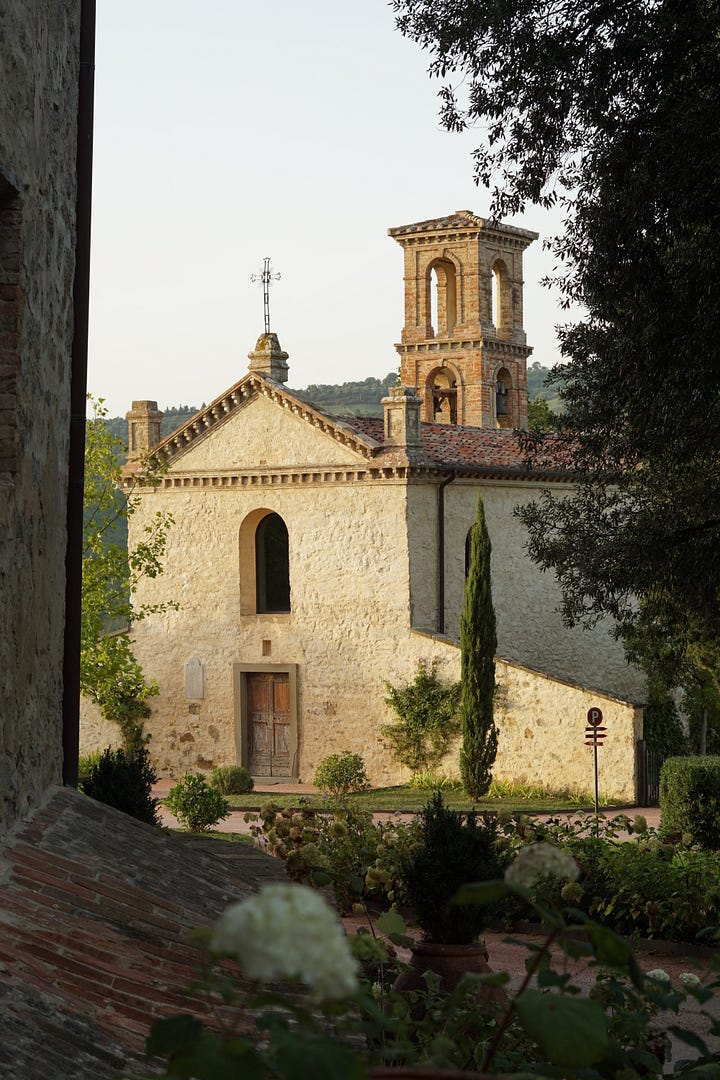
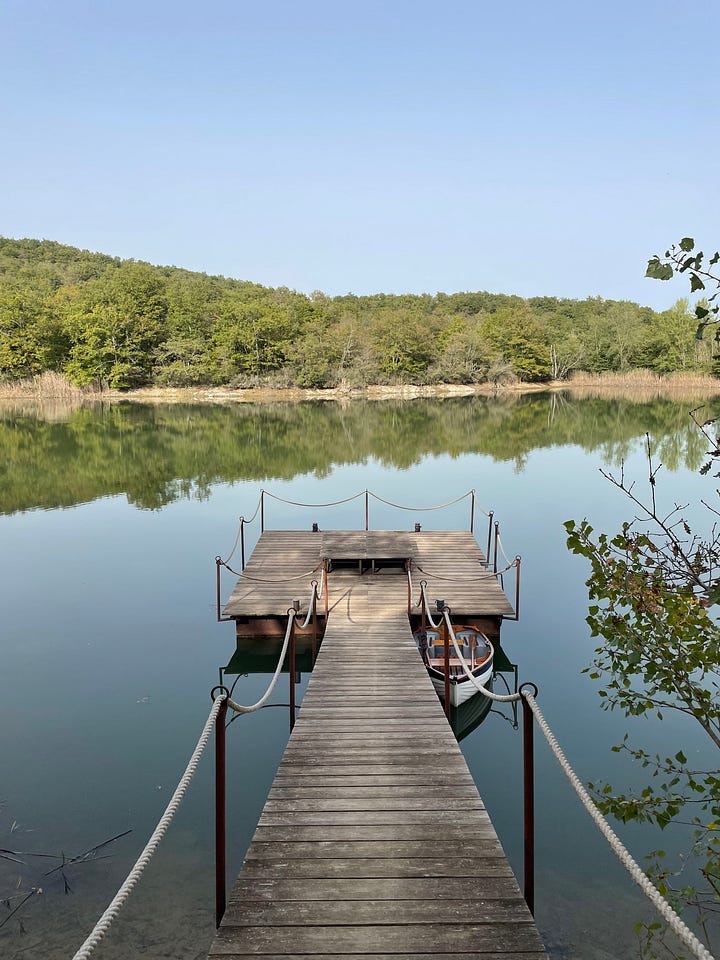
I packed my workout gear but, as usual, there was not enough time to use it. Had I woken up earlier on any given day, I would’ve taken advantage of the indoor gym located a short walk from the castle, or the surprisingly well-equipped outdoor gym on the hill next to the tennis courts. I also missed out on yoga, which is hosted within a gorgeous former church on-site, because we were wine tasting instead.
Tucked away somewhere on the estate, there’s a small lake and a cabin that guests can rent for the day for picnics and swimming, which would be very charming in the summer. You definitely wouldn’t see me in that water unless it was unbearably hot outside.
Dining & Drinking
Reschio has two restaurants: Ristorante Al Castello, a fine-dining option on the second floor of the main castle; and Ristorante Alle Scuderie, a more casual eatery several hundred meters away beside the terracotta-hued stable complex. Both breakfast and dinner are served at Ristorante Al Castello, where the morning buffet spread is a cornucopia of local foods, and the ginger tea served from incredible swinging pots is almost guaranteed to cure a cold. In the evening, highlights from the myriad dishes we sampled were the hare tortelli and the scallops, but all of the food was very good.
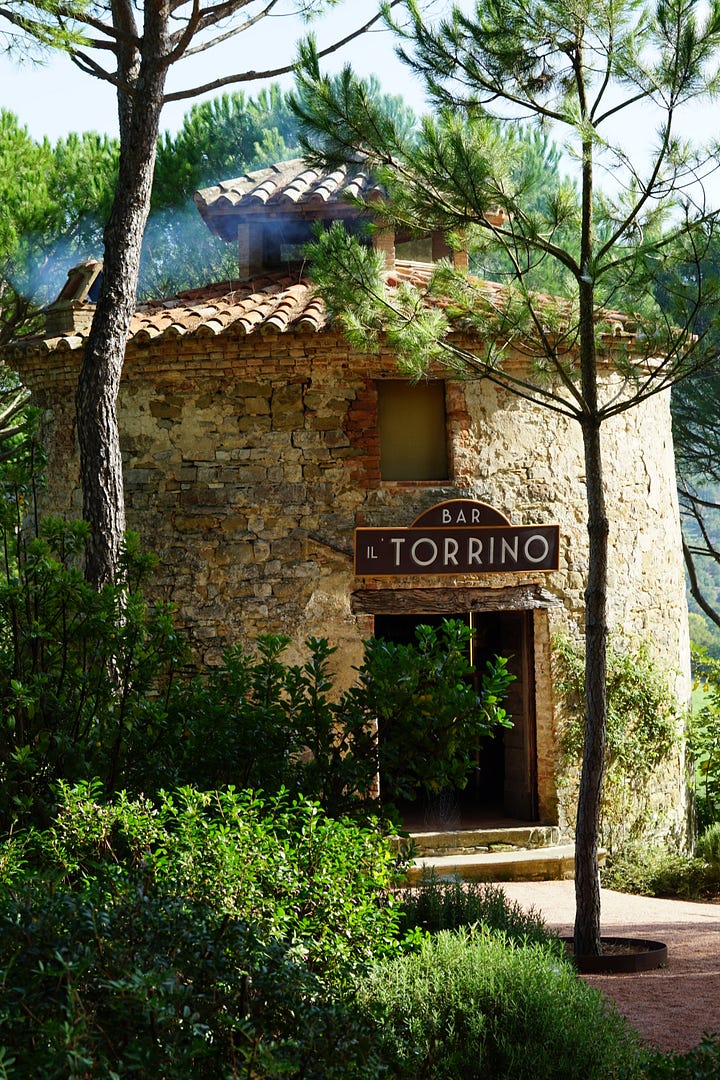
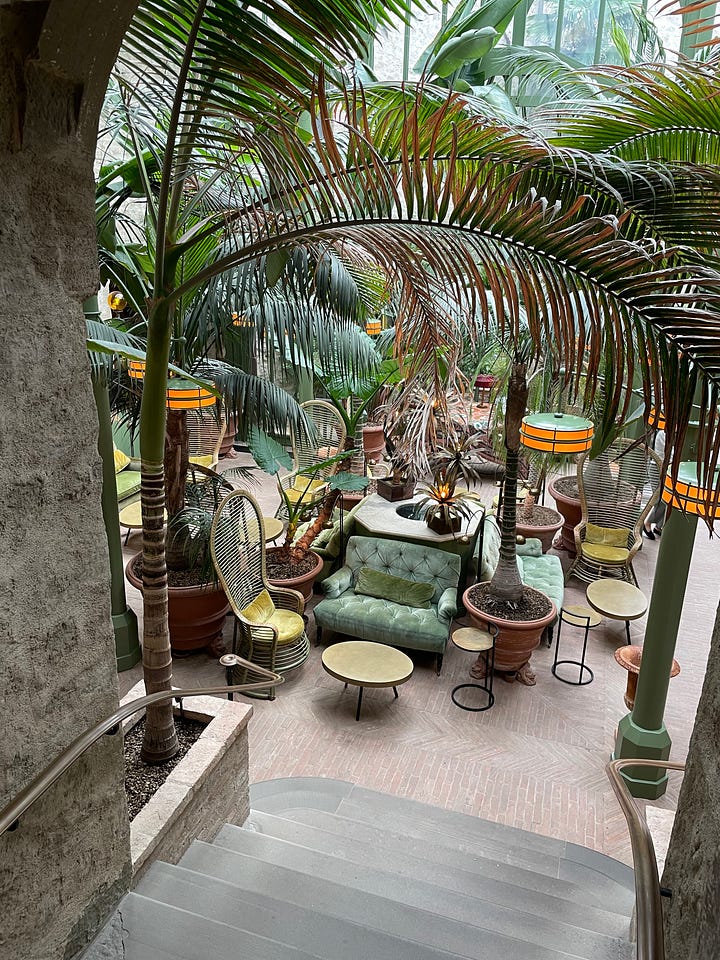
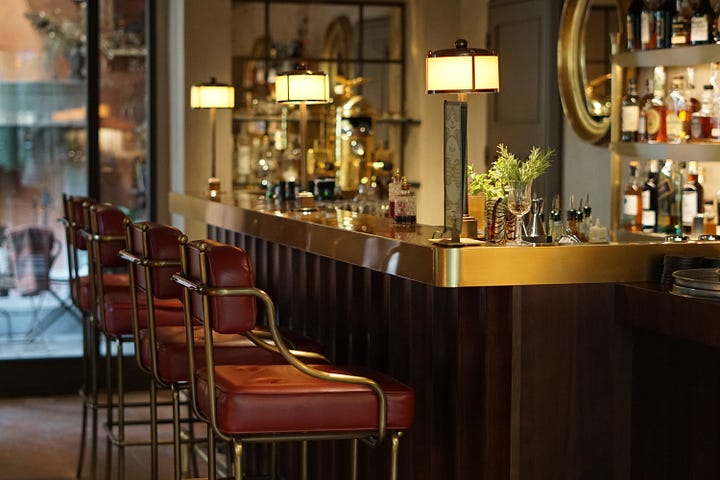
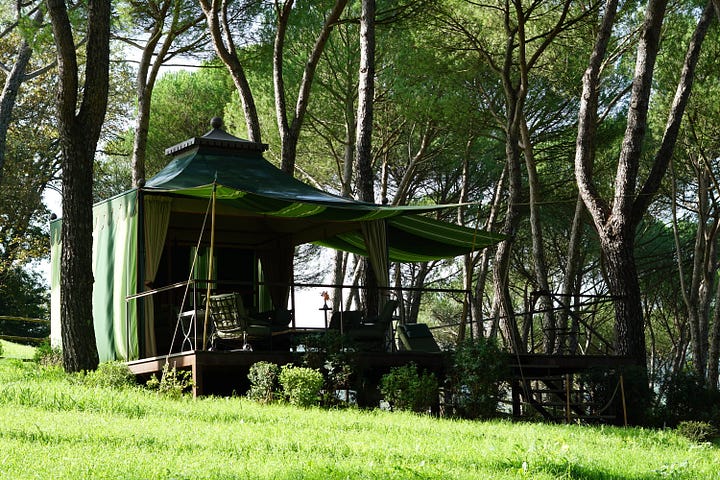
At Ristorante Alle Scuderie, lunchtime pizzas and the nettle-based minestrone soup were top-notch. Sitting out on the terrace, overlooking the pastoral landscape, feels quintessentially Italian and is undoubtedly the scene of some very long lunches. Dinner is served here too, with the same menu minus the pizza, and the restaurant also has a room behind the bar for wine and, amazingly, olive oil tastings—both of which were very eye- and palette-opening experiences.
For poolside drinks and bites, Bar Il Torrino is housed within an old stone rotunda that was once a watchtower, and caters to those lounging by the water or relaxing on the adjacent terrace. Up the hill, a large private cabana can be booked for the day by those famous enough to require extra privacy and personal service.

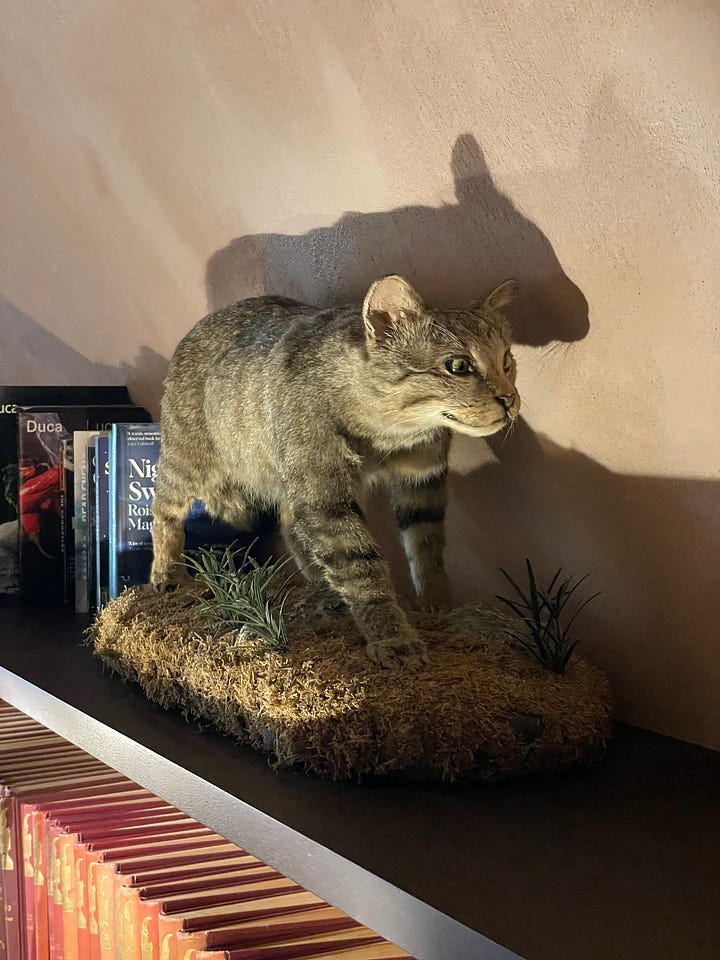
Back in the main castle, the small Bar Centrale off the Palm Court serves morning macchiatos, and nighttime Negronis as part of an inventive cocktail menu. These can be enjoyed amongst the palms, occasionally accompanied by live jazz, or in a back library/snug space that features a rather terrifying taxidermy cat that still haunts my dreams. Bar Centrale also connects to the Boot Room, perhaps my favorite spot on the property. Filled with bunches and bushels of freshly picked wildflowers, this cozy niche that opens to the courtyard is dominated by a grand fireplace where guests can warm themselves on a chilly evening with a drink.
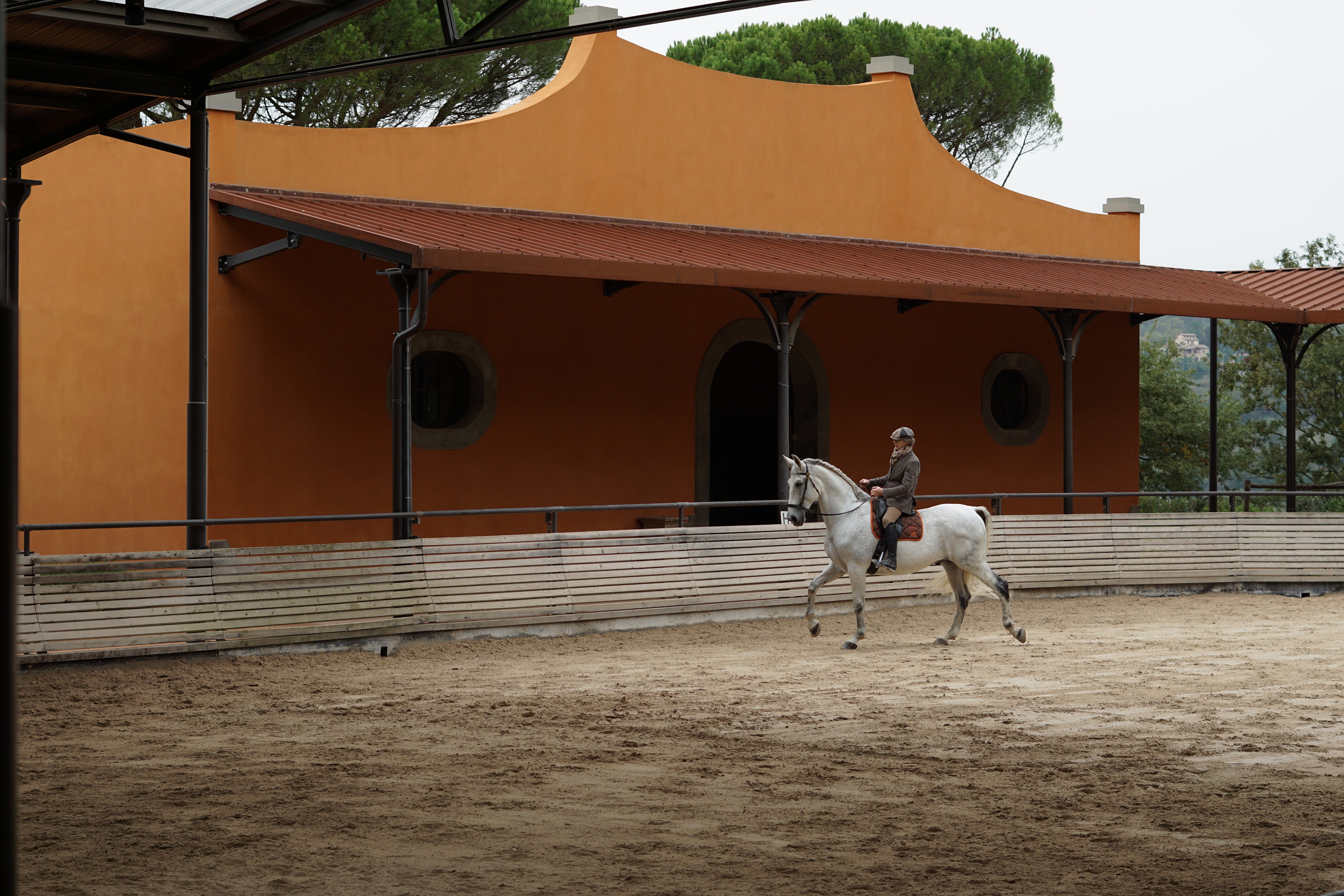
Horsing Around
A random but relevant fact: I’m allergic to horses. Which was a particular bummer while at Reschio, because the estate is home to 32 Spanish purebreds who have their own training center and performance theater, and are available for guests to take out on hacks across the estate. I obviously did not do this, but I did brave a dressage demonstration in the name of journalism to gain at least a little insight into equestrian life on the property.
The performance, and following explanation about horse training, was given by Antonello Radicchi, the head of the stables who trains all of the horses at Reschio. It was genuinely amazing, and to witness the love and care that Radicchi and all the staff bring to the animals (these never use whips or bits) was very heartwarming. We also spotted a family of wild boar including little boar-lets close to the stables, as well as several small deer during the stay, and were told that the estate is home many bird species, foxes, and even wolves on occasion. We did happen to be there during a full moon…
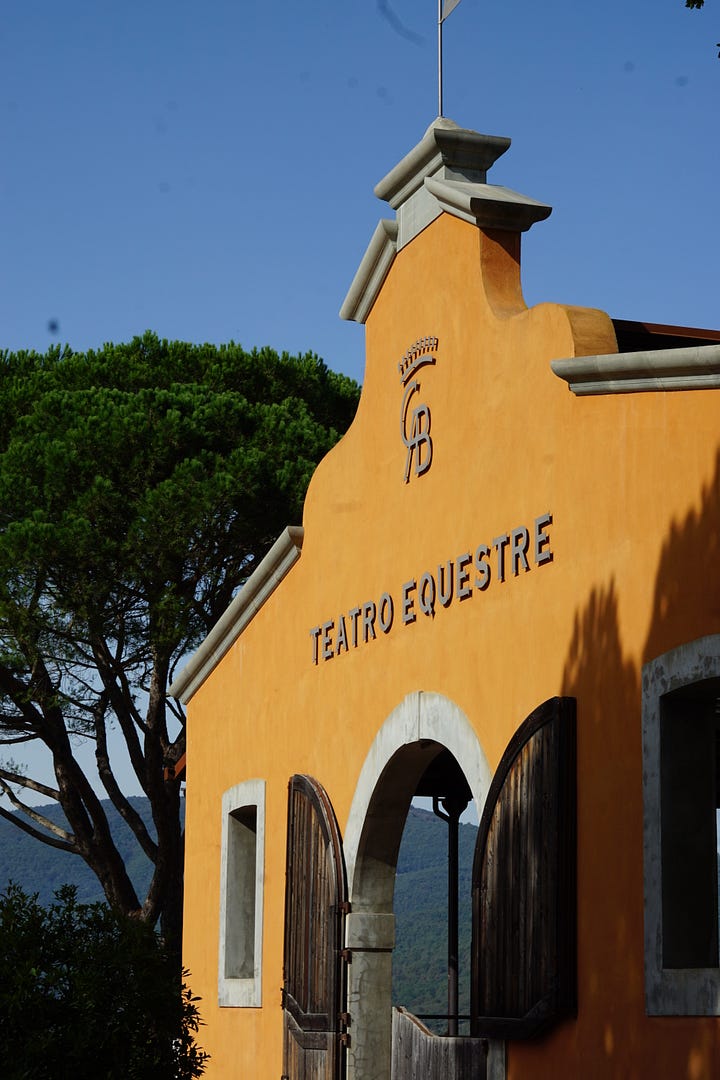
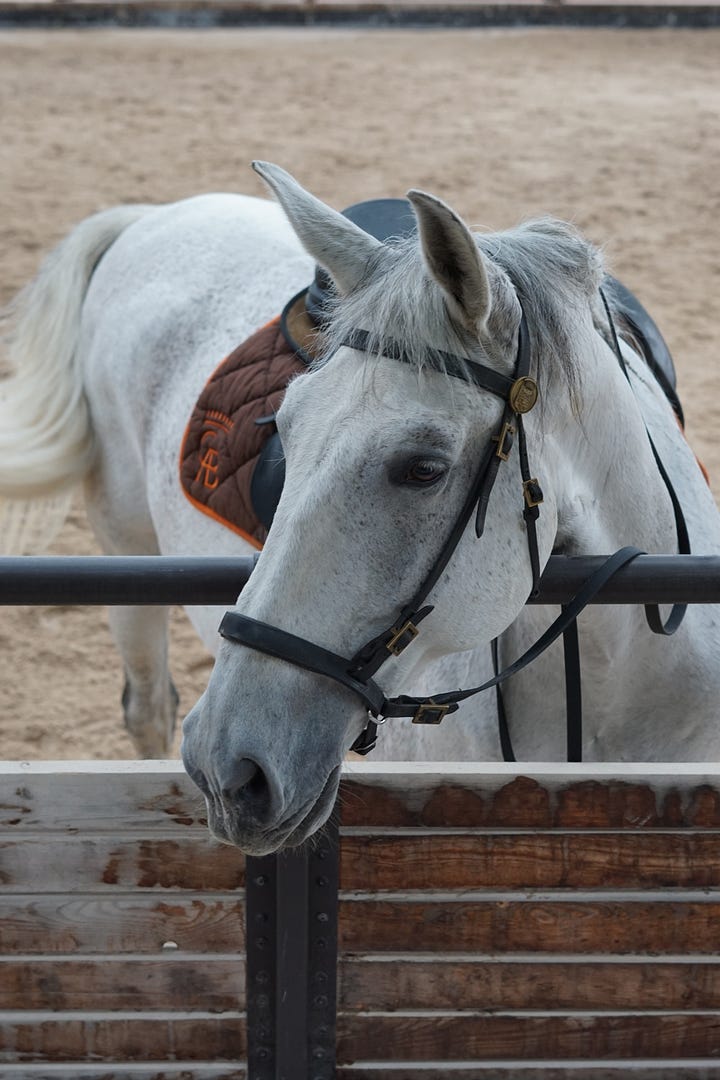
This visit to Umbria really helped to expand my knowledge of the region, and fostered a deep appreciation for it as a destination. Even though my first trip involved driving across a large portion of the countryside, the routes and stops were all dictated by the organizers, so I was really only following instructions. This recent tour was largely self-guided, and required a lot more research and planning, which made it all the more special.
As well as Reschio, I stayed at two other very unique properties during my week-long trip (which I hope to showcase separately at a later time) and by doing so, I gained a better understanding of the wealth of options Umbria has to offer those looking for a new travel experience that still feels quintessentially Italian. Highly recommended for spooky season, too. The tour-bus groups can continue raiding Tuscany, and we’ll keep Umbria our little secret. Promise?
Thank you’s
Okay a lot to get through this time. Thank you firstly to Leanne Drago for inviting me to Reschio. You fulfilled a dream many years in the making! Thanks to Izzy Harden at Bird PR for all the on-the-ground coordination and ensuring our stay went so smoothly, as well as being great company. Thanks to my trip-mates: Aimee Farrell for your sweetness and the spooky chats; Marshall Heyman for your quick wit and inquisitiveness (I know you’ll eventually find out who owns that villa!), and for the extra Venetian slippers; Fiona McCarthy for being my drinking and swimming pal, and giving the best seven-second hugs ever.
Count Benedikt Bolza and Donna Nencia Corsini, immense gratitude for having us, inviting us into your home, and sharing your story about a truly unique life and project. All of the staff at Reschio, you elevated the experience to a whole new level, and your attention to detail will not be forgotten. Particularly Mirko, for your incredible knowledge about wine and olive oil, which I’m determined to remember and impart to others. And last but certainly not least, Shelley-Anne Claircourt, who regales the most sensational and entertaining stories, drives a Land Rover like a stunt person, and has the most extreme menu indecision I’ve ever witnessed.


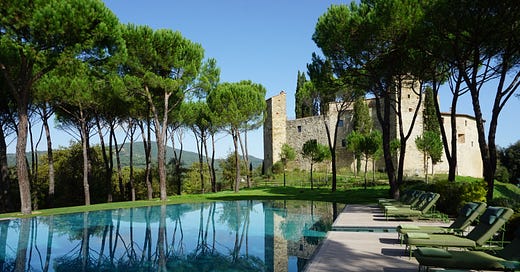



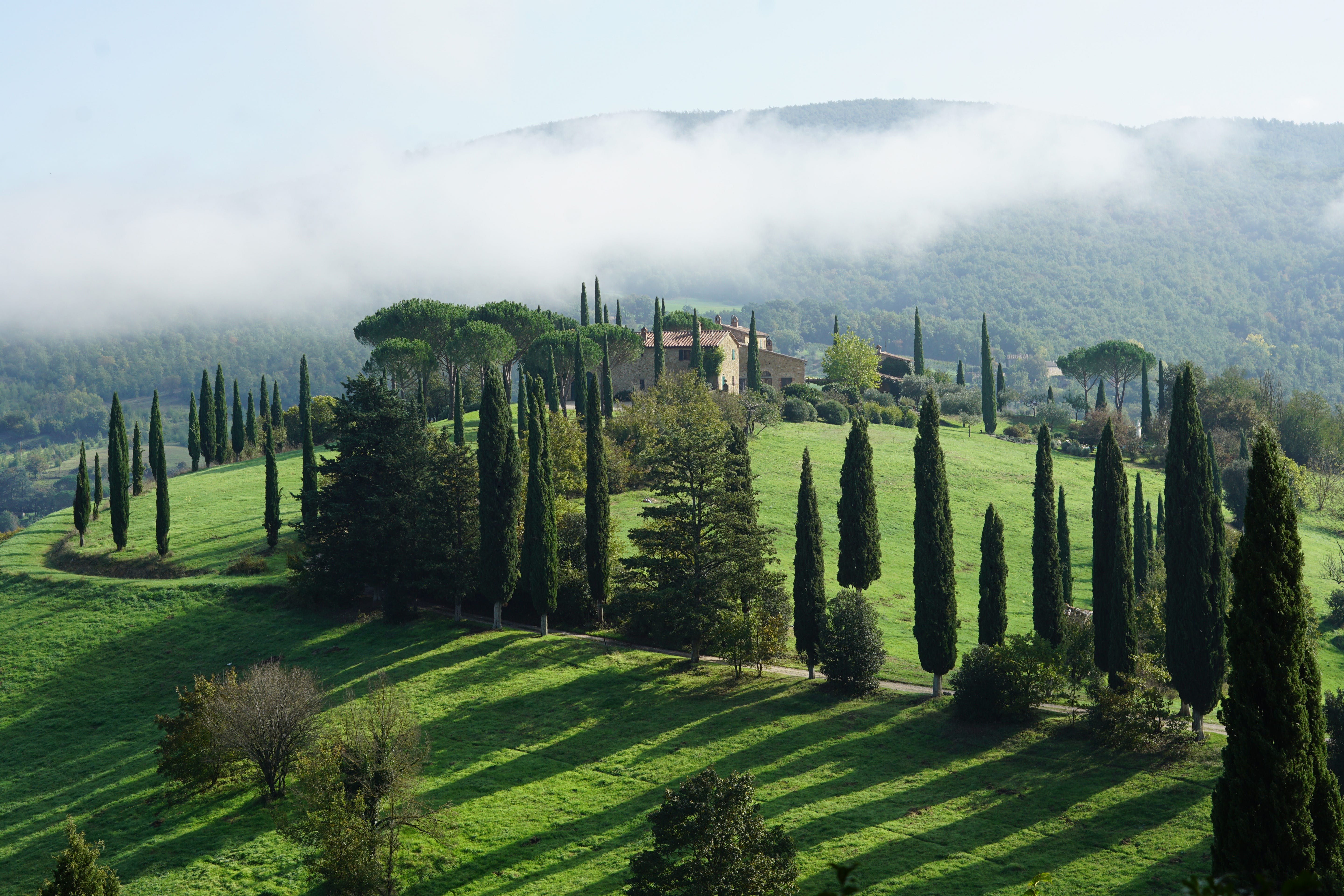
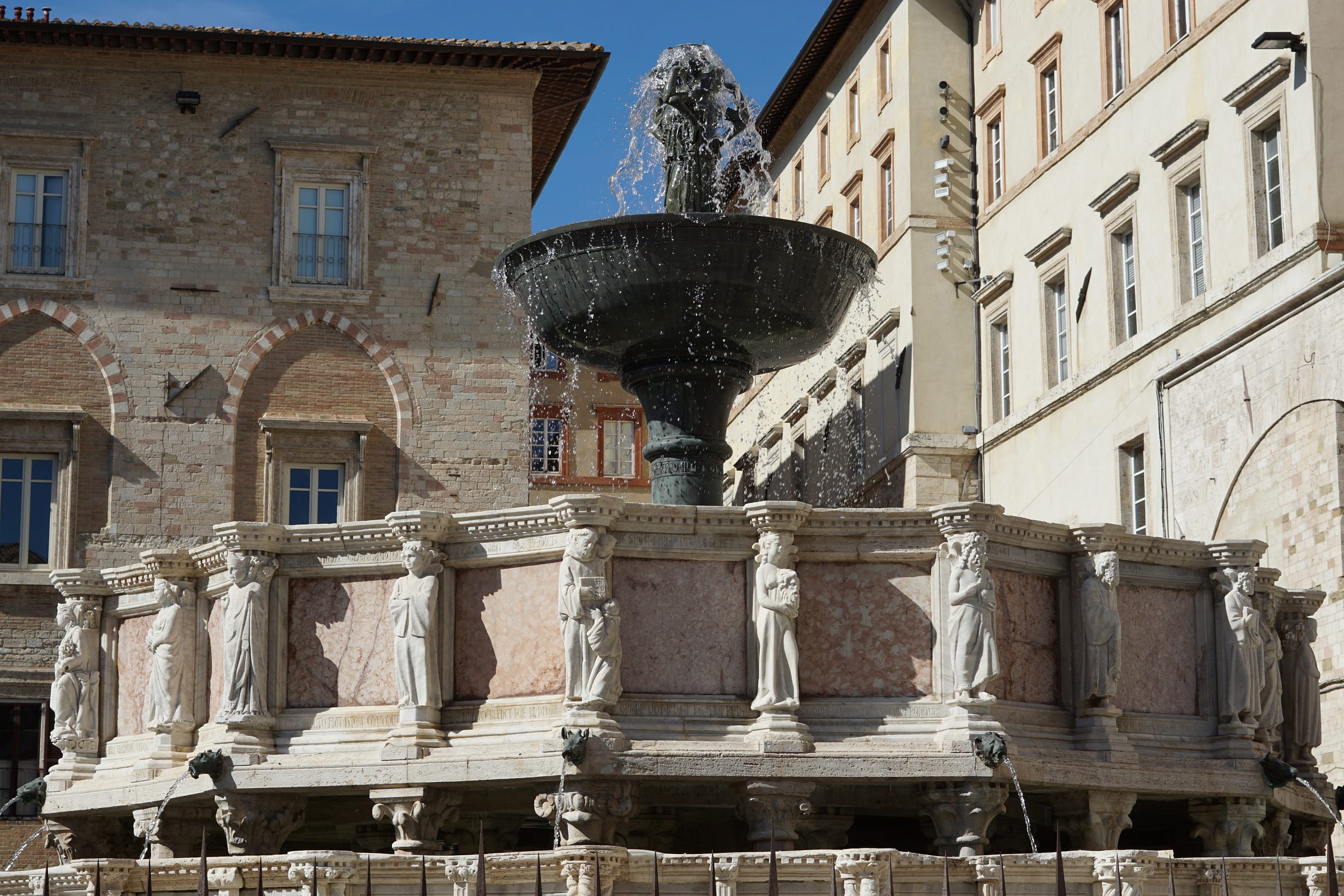
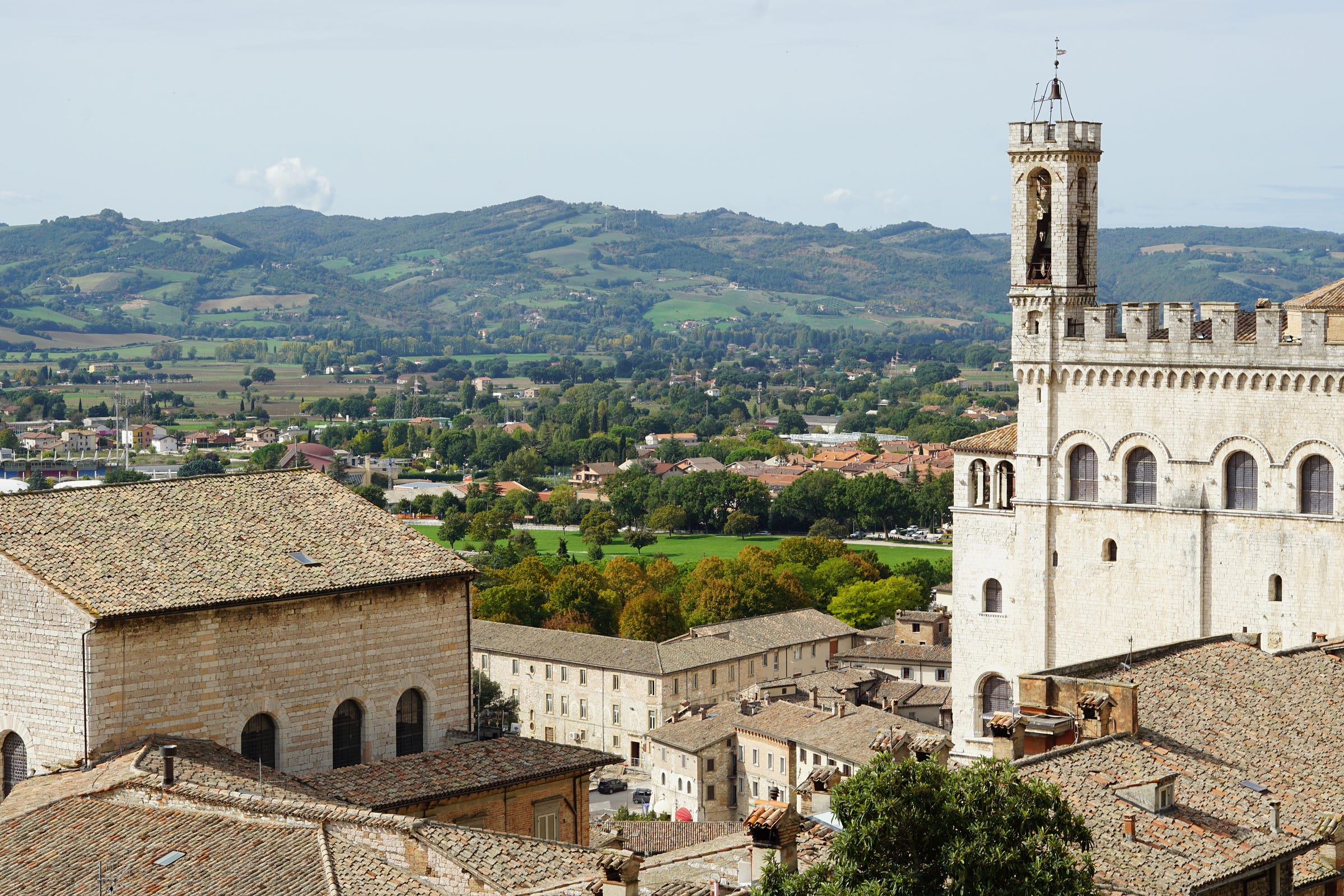
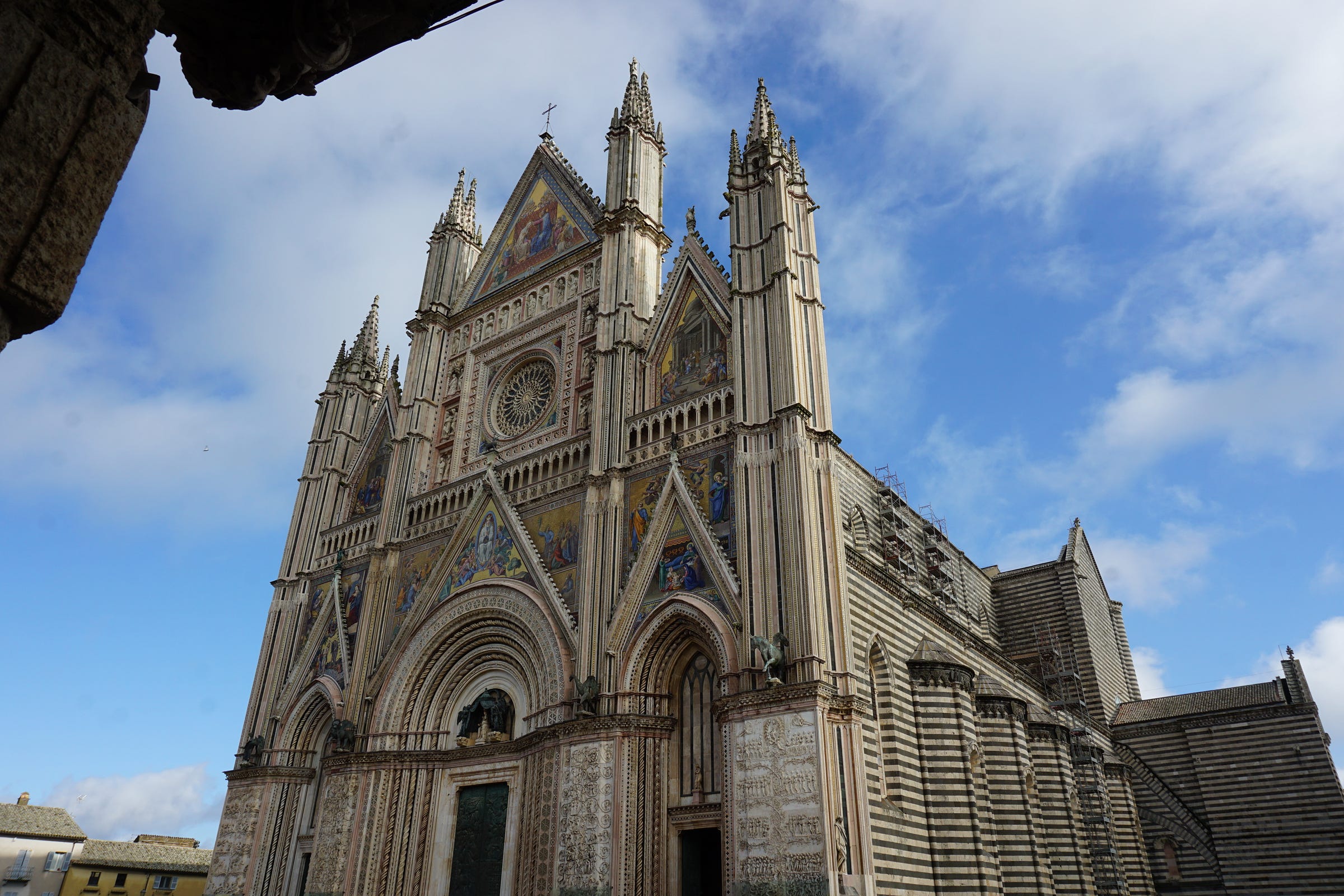
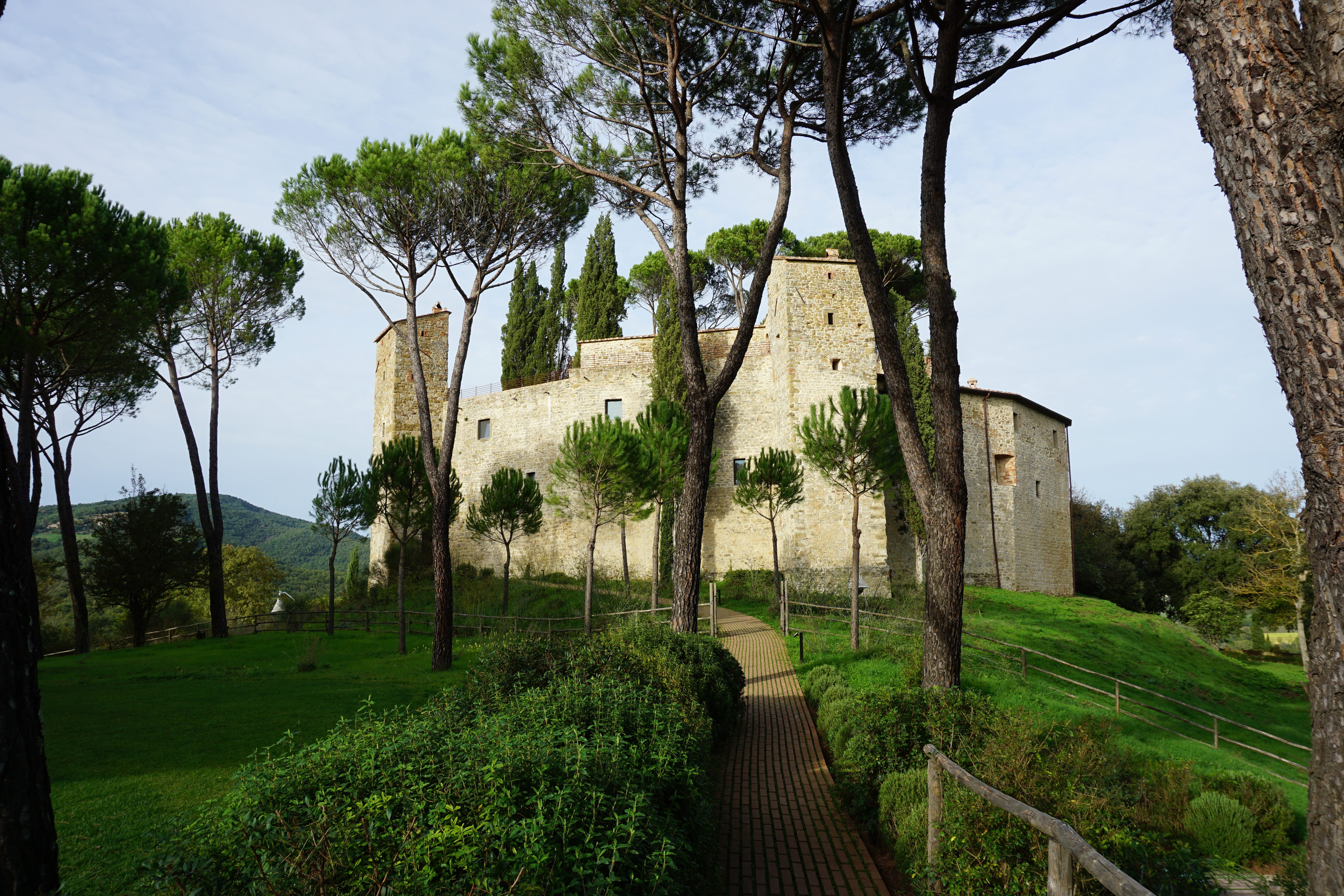
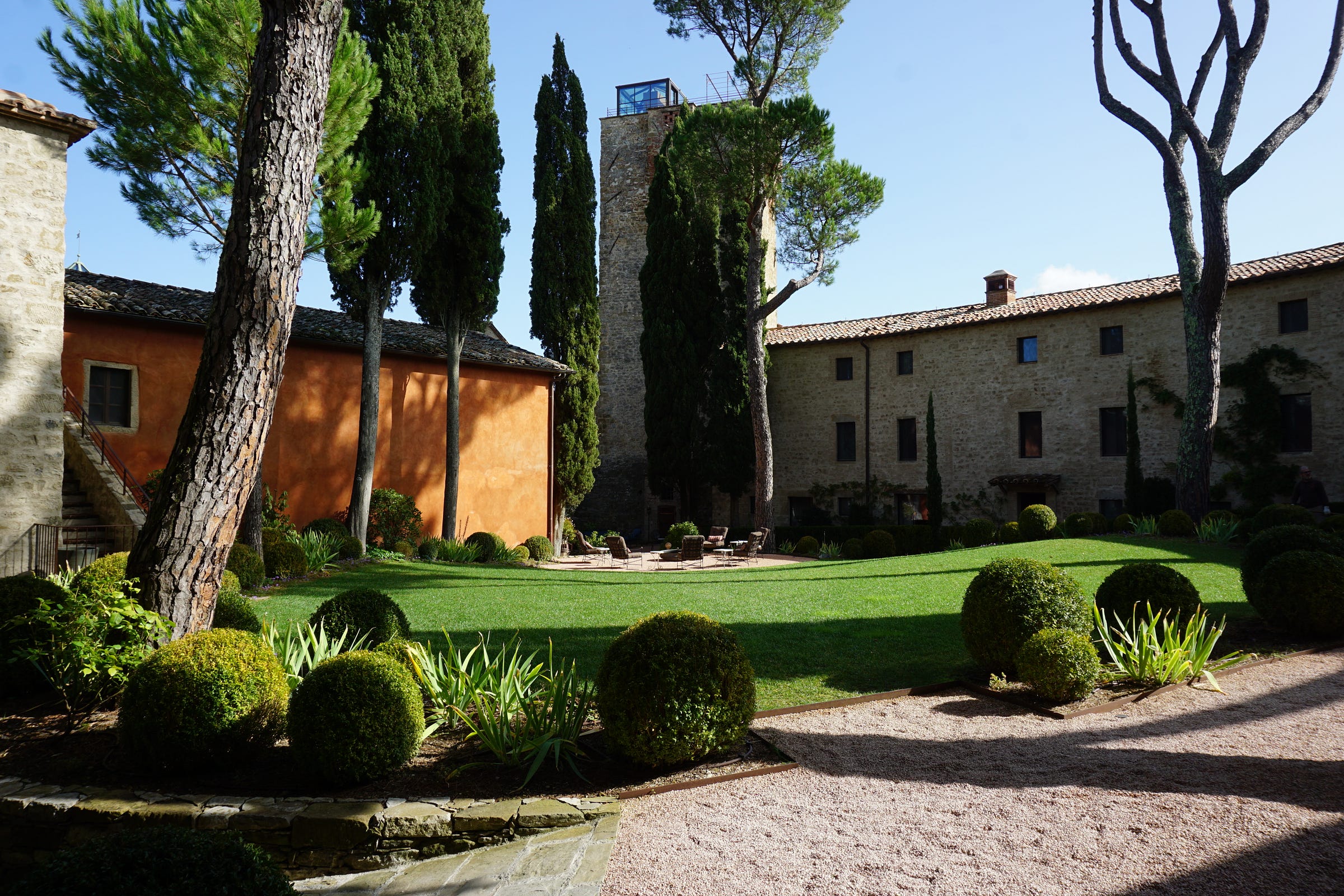
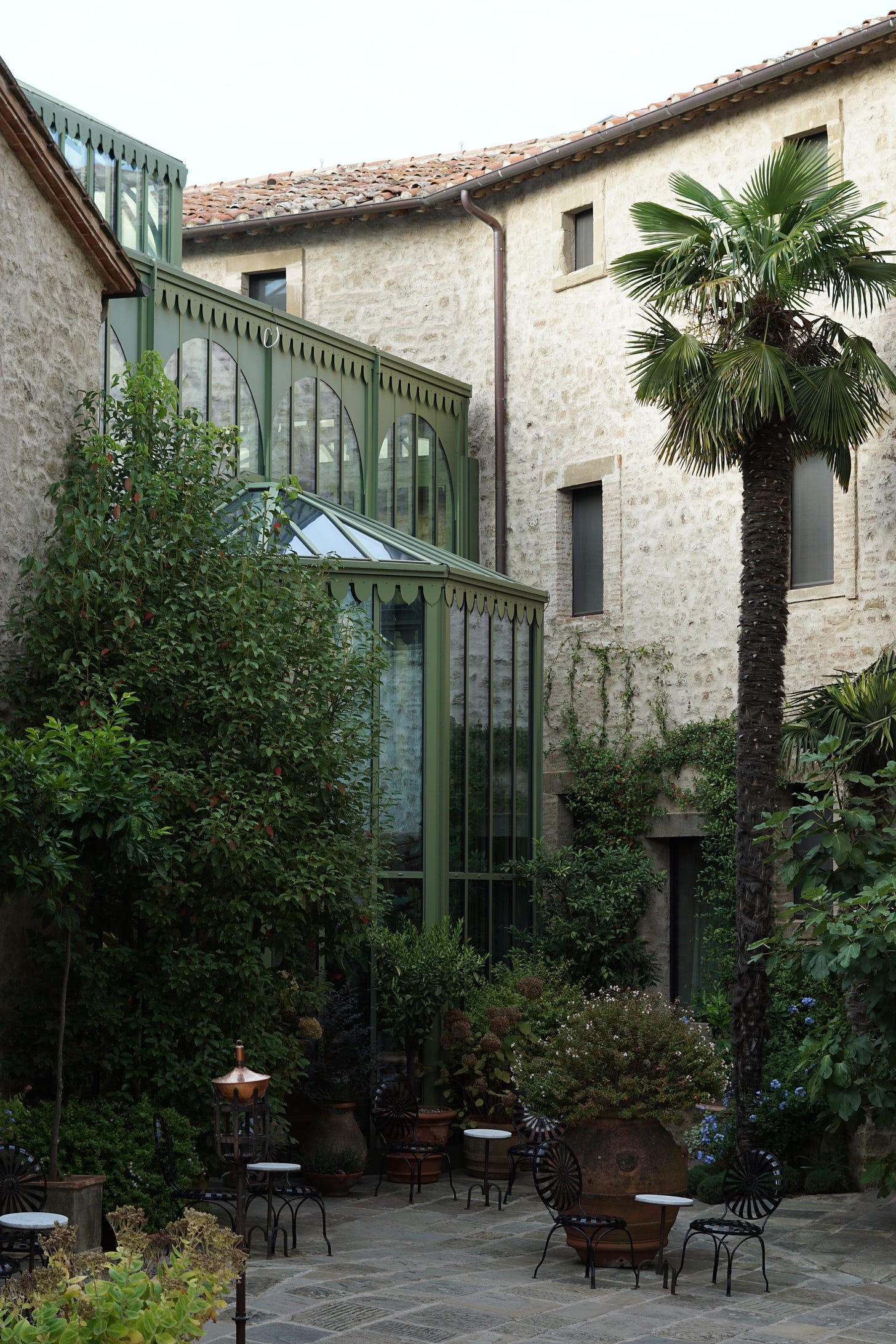
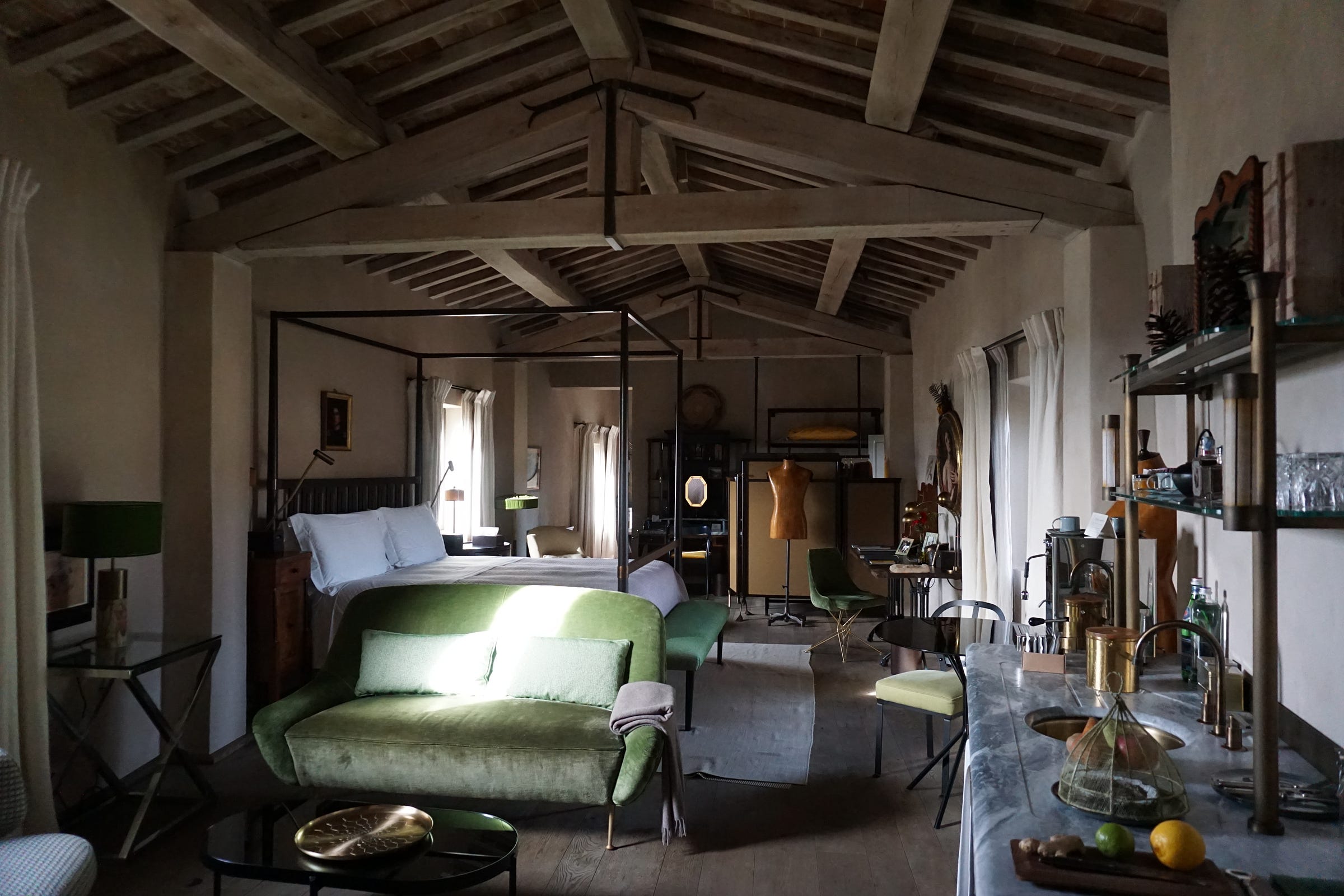
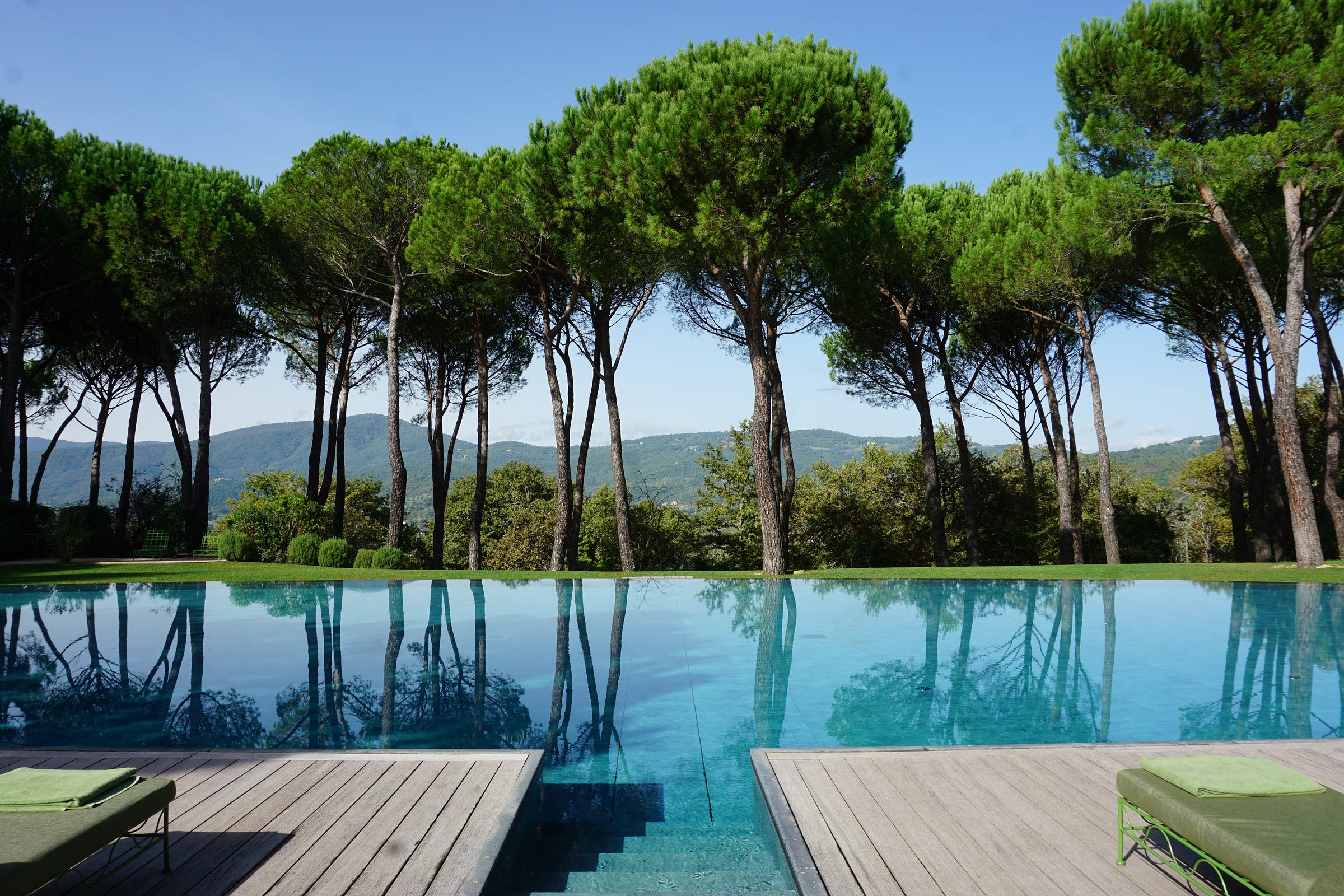
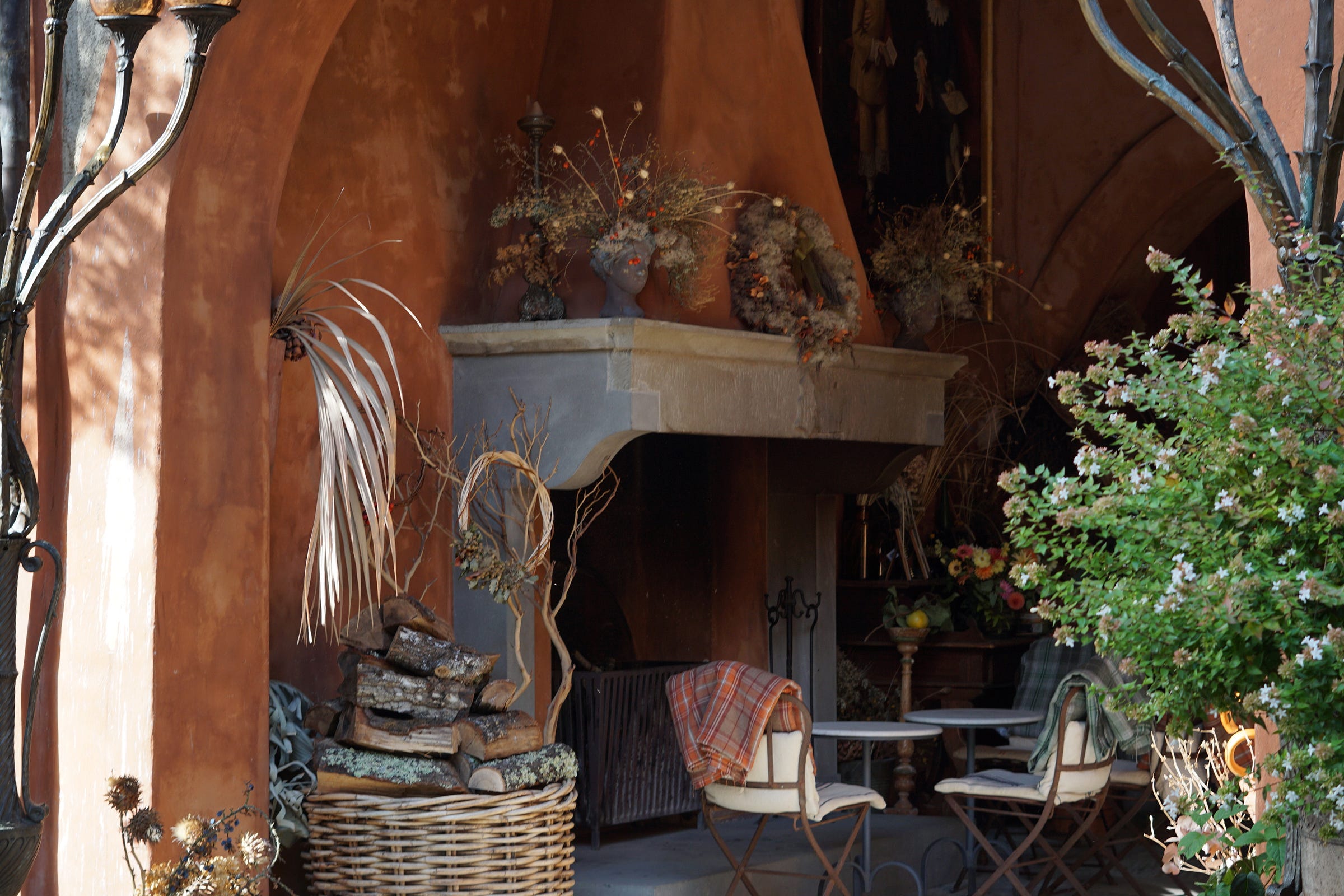
Stunning work!